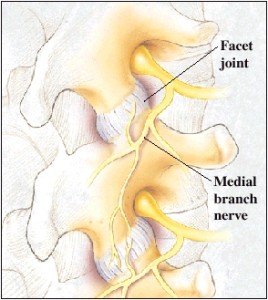What is a Medial Branch Block?
A medial branch block helps to diagnose problems with the medial branch nerves. Medial branch nerves are small nerves that feed out from the facet joints in the spine. And these nerves carry pain signals from the facet joints to the brain.
The medial branch block is often used as part of a 2-step diagnostic and treatment approach:
- Role of a Medial Branch Block
Is a procedure in which an anesthetic is injected near small medial nerves connected to a specific facet joint. Typically several levels of the spine are injected in one procedure. If the patient experiences marked pain relief immediately after the injection, then the facet joint is determined to be the pain source. - The procedure is primarily diagnostic, so if the patient has the appropriate duration of pain relief after the MBB, then they may be a candidate for a subsequent procedure. This next procedure is called a medial branch radiofrequency neurotomy (or ablation) – for longer term pain relief.
Role of a Medial Branch Radiofrequency Neurotomy (Ablation)
A radiofrequency neurotomy can be considered in cases where a medial branch block has confirmed a patient’s pain originates from a facet joint. A radiofrequency neurotomy can possibly provide longer term pain relief.
Facet Joint Injections
At times, a medial branch block is tried after the patient has already been treated with one or more facet joint injections, although this is not always the case.
A radiofrequency neurotomy is an injection procedure in which a heat lesion is created on the nerve transmitting a pain signal to the brain. The goal of a radiofrequency neurotomy is to interrupt the pain signal to the brain. While preserving other functions of the nerve, such as normal sensation and muscle strength.

Medial branch nerves are small nerves that feed out from the facet joints in the spine and carry pain signals from the facet joints to the brain.

The medial branch nerve block is designed to interrupt the nerves ability to transmit the pain signals to the brain, which in turn will determine – or diagnose – if the facet joint(s) is the source of the patient’s pain.
Facet joint injections involve an injection of anti-inflammatory steroid solution directly into the joint. A medial branch block may be considered if a facet injection, along with other treatments doesn’t result in long term pain relief. Other treatments following a facet injection can include physical therapy, manual manipulation, and medications.
As evidence evolves on the efficacy of facet joint injections, a medial branch block may also be considered instead of a facet joint injection. A medial branch block might also be considered first if the steroid and/or an injection directly into the facet joint cannot tolerated.
For the facet joints, the medial branch nerves are the small nerves that carry pain signals to the brain.
Facet joints are pairs of small joints that are situated at each vertebral level of the spine. A facet joint may also be called a zygapophysial joint or a Z-joint.
Medial Nerves
Each facet joint is connected to two medial nerves that carry pain signals away from the spine to the brain.
The medial nerves are uniquely located in each segment of the spine:
- Cervical medial branch nerves are located in a bony groove in the neck
- Thoracic medial branch nerves are located over a bone in the mid-back or upper back
- Lumbosacral medial branch nerves are found in a bony groove in the low back
Medial Nerve Function
The medial branch nerve block is designed to interrupt the nerves ability to transmit the pain signals to the brain, which in turn will determine – or diagnose – if the facet joint(s) is the source of the patient’s pain.
These medial branch nerves do not control any major muscles or carry any sensation in the arms or legs, so there is no danger of negatively affecting those areas – or negatively affecting other pain sensing processes – with a medial branch block.
The medial branch nerves do control small muscles in the neck, the mid and lower back, but loss of these nerves has not proved harmful.
Medial Branch Block Procedure
As with many spinal injections, medial branch nerve block procedures are best performed under fluoroscopy (live X-ray) for guidance in properly targeting the nerves, placing the needle, and avoiding injury.
On the day of the injection, patients are advised to avoid driving and doing any strenuous activities, and to get plenty of rest the night before.
Medial Branch Nerve Block Steps
The medial branch injection procedure includes the following steps:
- Commonly, the procedure is performed without any sedation, however, an IV line can be started if relaxation medicine is needed
- The patient lies face down on an procedure table, and the skin over the area to be tested is well cleansed
- The physician treats a small area of skin with a numbing medicine (anesthetic), which may sting for a few seconds
- The physician uses X-ray guidance (fluoroscopy) to direct a very small needle over the medial branch nerves
- A small amount of contrast dye is then injected to confirm that the medicine covers the medial branch nerve
- Following this confirmation, a small amount of numbing medicine (anesthetic) will then be slowly injected onto each targeted nerve.
The injection itself only takes a few minutes, but the entire procedure usually takes between fifteen and thirty minutes.
After the Injection
After the procedure, the patient typically remains resting in the recovery area for 20 to 30 minutes. The physician will then ask the patient to perform some movements or activities that would usually provoke the pain. This assessment is done in order to determine if the medial branch nerve block has reduced the patient’s pain.
 Skip to content
Skip to content
